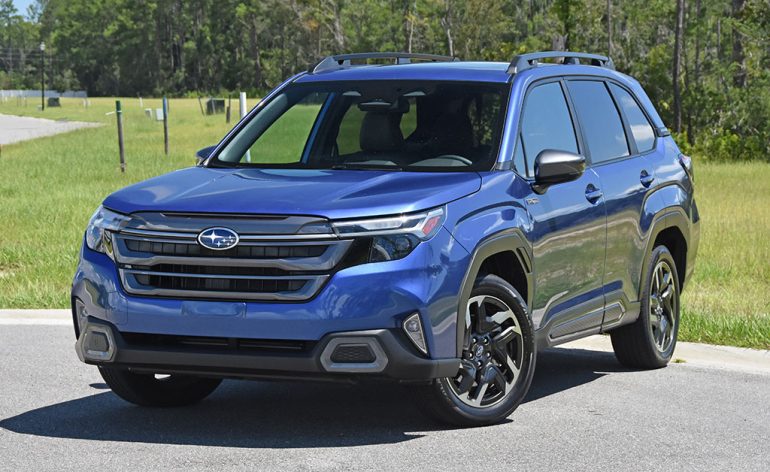
The rather consistent and expected Subaru theme has played well for many decades, and such a formula hasn’t changed much – which can be considered as a good thing when you factor in the success of the brand. Having a full lineup of all-wheel-drive vehicles, sans the BRZ sports car, Subaru has done well to serve the masses with respected and mostly economical transportation devices that have an off-roading edge over most.
The Subaru brand has been methodical about its approach to redesigns, as they have in the latest 2025 Subaru Forester, a vehicle that’s had a steady hand at offering up a tall-statured and somewhat compact-sized crossover. For the new model year, Subaru redesigns the Forester and brings us a hybrid option, which I had the opportunity to check out this week.
The new Subaru Forester retains some of its traditional boxy yet frumpy-looking build, in addition to its off-roading prowess in having extra ground clearance, as much as 9.2 inches in the rugged new Wilderness trim and about 8.7 inches in my Forester Limited Hybrid test vehicle. Where the new Forester plays nicely in retaining its off-roading abilities is having a respected balance for its on-road feel, where there’s not much compromise other than some body roll when pushed near its limits. Otherwise, the new Forester is improved upon in many areas but retains the outgoing generation’s power level with the 2025 model, with 180 horsepower and 178 lb-ft of torque that’s sent through a continuously variable transmission (CVT). Such a combination is a sad experience for enthusiasts. However, moving to the new hybrid setup for the 2025 model year, the first time for a Forester Hybrid, power increases slightly to a total of 194 horsepower and about 199 lb-ft of torque thanks to the electric motor portion of the hybrid system. The 118-horsepower electric motor factors into the 2.5-liter Atkinson-cycle flat 4-cylinder engine’s 162 horsepower and 154 lb-ft of torque – not to exactly add on the figure but to ‘factor’ it in as the system manages power output through a CVT.

The hybrid powertrain setup is nothing new under the sun, but how the Subaru Forester transmits its power out to all four wheels is something that’s somewhat rare for its class. Here, Subaru routes the power through a transfer case after the hybrid system and CVT transmission, meaning all four wheels are driven by the output of the engine and hybrid system working together or decoupled with electric energy from the smallish 1.1-kWh lithium-ion battery pack. Such a setup feels more adept at sending power to manage off-roading adventures better than most in its class, where other hybrid setups may utilize an electric motor only to power the rear wheels, leaving the fronts connected to the engine in some fashion.
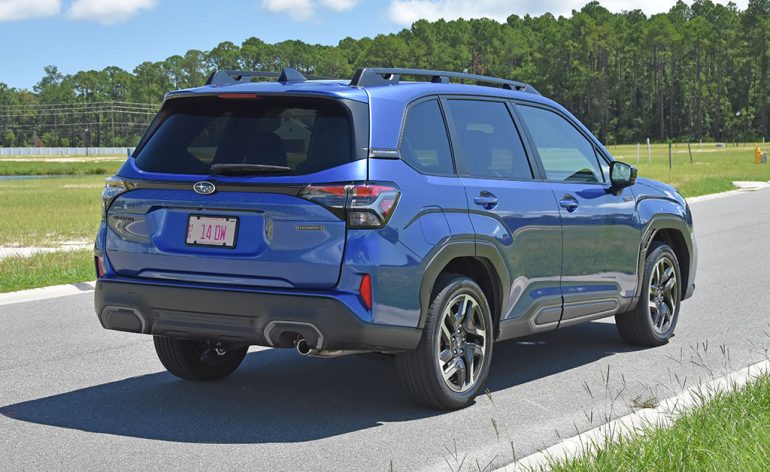
Overall, the performance of the new Forester Limited Hybrid is good on the road, and its target buyers won’t balk much. However, the overall acceleration leaves some to be desired, even with the hybrid having about 14 more ponies and a good deal of extra torque that willingly fills some power gaps in the gas engine with its instant torque propulsion. Getting up to 60 mph from a standstill will still take a bit, about 8.1 seconds, which is a bit quicker than the non-hybrid Forester, taking 9.2 seconds.
The good qualities about performance is a ride quality that feels more refined and adapts better to the road to exude a smooth and well damped experience. Though, there’s some front-end body rise and dive upon heavy acceleration or braking – but that extra suspension travel doesn’t upset the good ride quality on larger road imperfections, including rises and undulations.
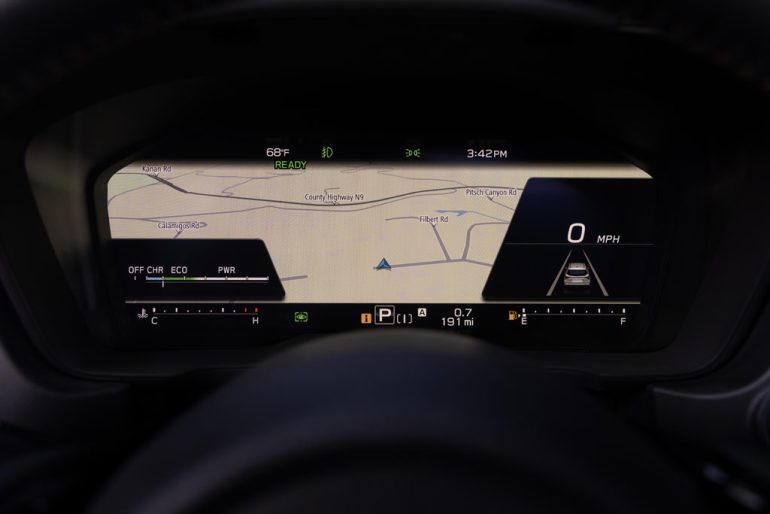
Fuel economy in the real world for being a hybrid comes close to the EPA estimates of 35 mpg city, 34 mpg highway, and 35 mpg combined. Surprisingly, the real-world estimates are consistent when you finally settle on racking up 20 or more miles – otherwise, you can easily surpass the 35 mpg figure to get 40 mpg or more if you’re conscious of how much throttle effort you can get away with at low speed before the gas engine kicks over. The hybrid system is almost like those from Toyota, but seems to fire up the engine under a much lighter load than most and seldom permits just electric driving situations – even with an EV mode button ready to enable at low speeds with enough battery reserves. The transitions are smooth and done so without fault in firing up the engine in time to get things moving aggressively when demanded. Braking is also a smooth transition from braking regen to the use of the friction brakes, which prove to be rather strong, only followed up by that body dive that I had to get used to during my week with the redesigned Forester Hybrid.
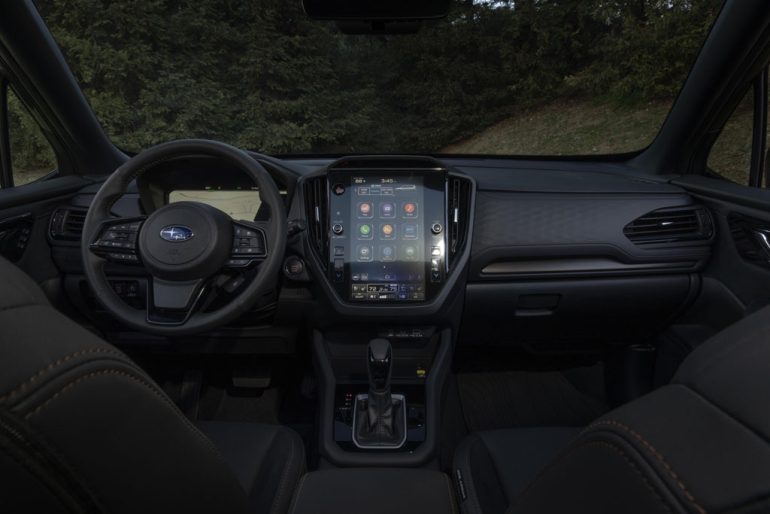
The interior of the new Subaru Forester Hybrid Limited is as plush as such a vehicle has ever been. If you’re at all familiar with the Subaru theme, there’s been a long history of having an atrium of hard plastics all highlighted by the glaring sun blazing through the large windows. Now, thankfully, Subaru does something about all that hard plastic and offers up additional soft touch areas and adorned with some faux suede trim lines that all add to liven up the interior and give it more of a much-needed premium feel.
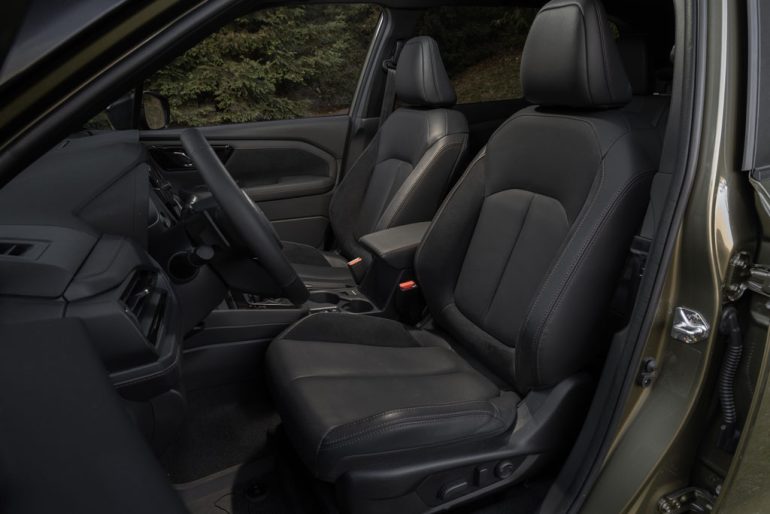
Also, Subaru does well in improving the seating areas with perforated StarTex water-repellent upholstery that does a good job of pretending to be leather. However, you can still get real leather in the top-level Touring trim, which is one of the few features that set it apart from other trims. The front seats get heating in the Limited Hybrid trim, reserving the ventilation feature for the Touring trims, either hybrid or non-hybrid. Seating areas are highly adjustable, providing easy accommodation for most-sized adults. Out back, the rear seats have generous room as well and shine with the high roof line to offer up ample headroom. Overall, the new Forester plays well for those who may cross-shop some mid-sized two-row crossovers.
In the area of technology, Subaru brings in the expected goods and does so with its 11.6-inch tablet style touchscreen and a new 12.3-inch configurable digital gauge cluster that allows you to display your mapping app from wireless Apple CarPlay or Android Auto integration in the cluster. There’s also a smartphone wireless charger in front of the shifter.

The one fault of the infotainment system I found to rear its ugly head quite often was the slow loading of the touchscreen system and its lagging response to inputs on occasion after its slow initial load. Such a hiccup becomes frustrating at times where the system would seemingly catch up to inputs pressed many seconds ago, even functions like pressing the heated seats mistakenly. I would think such an issue may be a simple fix through an over-the-air update- hopefully.
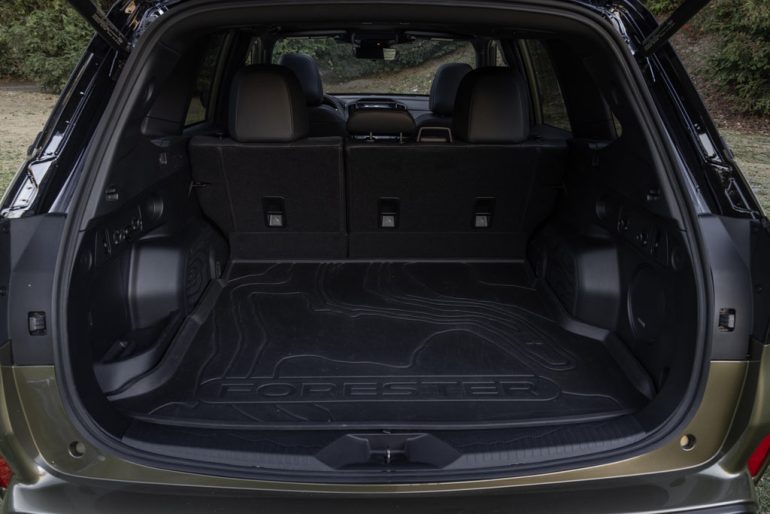
Apart from the slow response issue at times, the system works well with only a short learning curve and accessing primary functions where the system has physical buttons for the automatic dual-zone climate control temperature adjustments, volume knob, tuning knob, and front/rear defrosters.
Subaru remains at the forefront of safety, offering up all of the expected active safety features, but through their latest iteration of EyeSight driver assist system, adding functions such as emergency lane keep assist, adding an extra layer to the normal lane keep or lane departure warning/mitigation function. Also, the tracking of forward-facing vehicles seems to be on the sensitive side, even when you increase the distance, which could be a good thing for some. Otherwise, Subaru bundles up all of the goodies, including the typical blind-spot monitoring and adaptive cruise control with the lane keep assist to follow the road lines at speed.
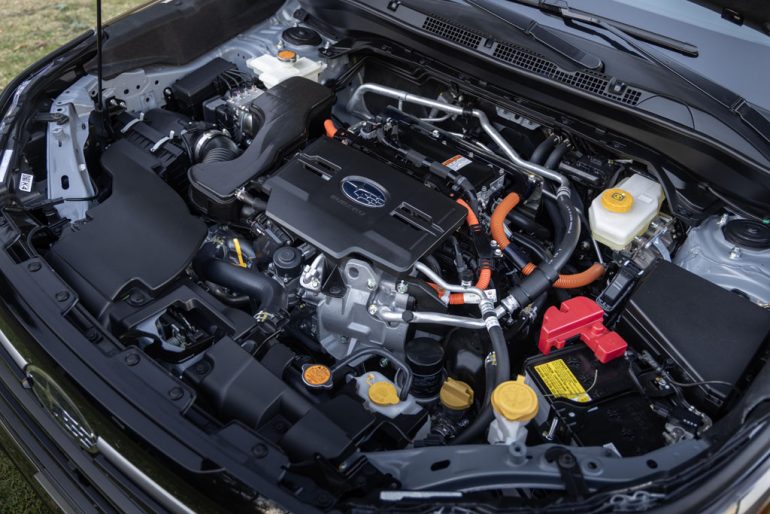
When it comes to value, Subaru keeps on pace as an attractive offering among competitors where the Forester non-hybrid starts at just $29,995 for the base trim but you may find pricing to mount quickly in going through the many trim levels arriving nearly at the top with my Forester Limited Hybrid testing out at $41,225, which includes a $1,420 destination and delivery charge.
FOLLOW US TODAY:

Malcolm Hogan is the founder and editor of Automotive Addicts, a trusted voice in the automotive media world for over two decades. With 20+ years of hands-on experience covering the industry, Malcolm has built a reputation for delivering honest reviews, sharp insights, and in-depth coverage of everything from new car debuts to high-performance test drives. Passionate about the evolving car culture and staying ahead of the curve, Malcolm continues to lead Automotive Addicts as a go-to destination for enthusiasts and industry insiders alike.


